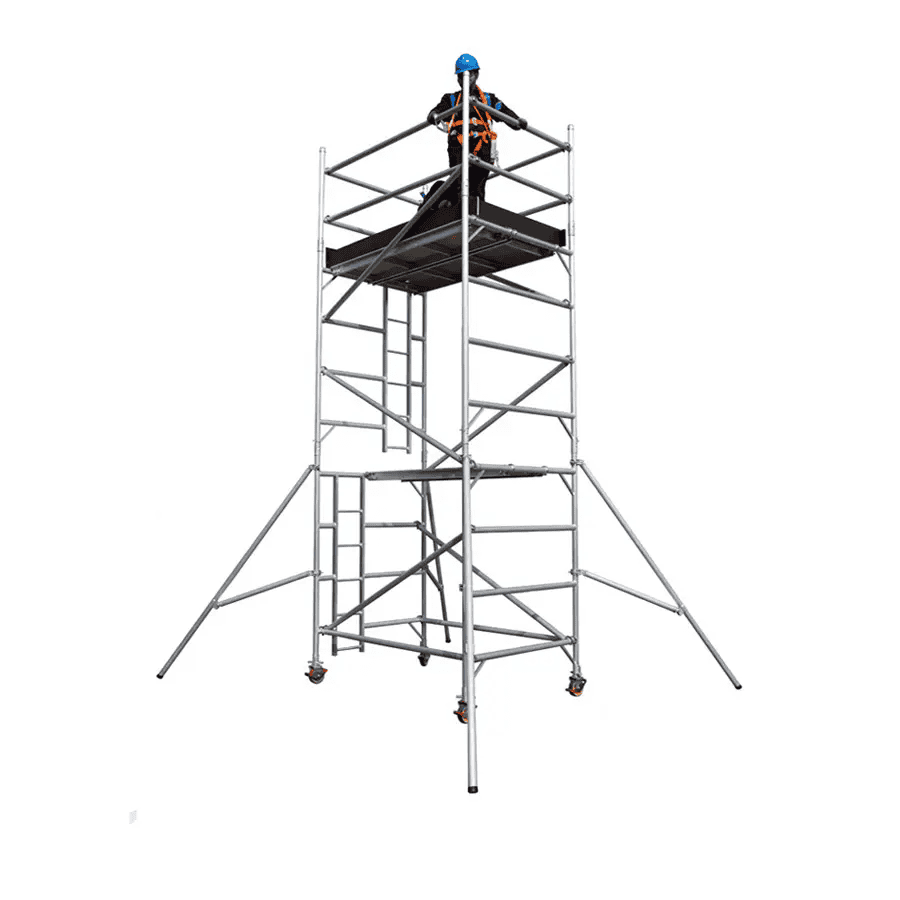 Light-duty, medium-duty, and heavy-duty scaffolding refer to different load capacities that scaffolding systems are designed to support. Here’s a breakdown of each category:
Light-duty, medium-duty, and heavy-duty scaffolding refer to different load capacities that scaffolding systems are designed to support. Here’s a breakdown of each category:
Light-Duty Scaffolding
- Load Capacity: 25 pounds per square foot (122 kg/m²)
- Typical Uses: Inspection, maintenance, and light repair work
- Suitable For: Supporting workers and light tools only
Medium-Duty Scaffolding
- Load Capacity: 50 pounds per square foot (244 kg/m²)
- Typical Uses: Brick masonry and similar construction work
- Suitable For: Supporting workers, tools, and construction materials like bricks and mortar
Heavy-Duty Scaffolding
- Load Capacity: 75 pounds per square foot (366 kg/m²)
- Typical Uses: Stone masonry and projects requiring storage of heavy materials on scaffolding
- Suitable For: Jobs where stored materials, workers, tools, and materials must be placed on the scaffold ahead of their installation
Key Considerations
- Safety: The scaffold and its components must be capable of supporting at least 4 times the maximum intended load without failure.
- Calculation: To determine the total rated load capacity, multiply the base rating (25, 50, or 75 lbs/sq ft) by the square footage of the scaffold’s work surface.
- Deflection Method: This technique can be used to determine if a scaffold exceeds its safe load limit. The planks on a loaded platform should not deflect more than 1/60 of the span.
- Maximum Board Span: OSHA has established requirements for the acceptable span of planks on scaffolding platforms, which vary based on the duty rating and lumber thickness.
- Worker Weight: When calculating load, all persons working on a scaffold are considered to weigh 250 pounds each.
By selecting the appropriate duty rating for scaffolding, you can ensure that it safely supports the required loads for your specific project needs while complying with safety regulations.
Scaffolding can be classified into light, medium, and heavy-duty types based on the weight they can support. Light-duty scaffolding supports up to 120 kg/m², medium-duty up to 240 kg/m², and heavy-duty scaffolding can hold up to 450 kg/m², making them suitable for different construction needs.
Now that you understand the general classifications, let’s explore the specific characteristics, load capacities, and common applications for light, medium, and heavy-duty scaffolding in various construction projects.
Table of Contents
What is Light-Duty Scaffolding?
Working on smaller projects? Light-duty scaffolding is suitable for light maintenance, painting, or repair jobs where the weight load does not exceed 120 kg/m², ensuring safety for minimal tasks.
Light-duty scaffolding supports up to 120 kg/m² and is typically used for lighter tasks like painting, cleaning, or minor repairs. It is portable and easy to assemble, making it ideal for smaller-scale construction or maintenance work.
Light-duty scaffolding is designed for projects that involve minimal loads and lighter tasks. It is commonly used in activities such as painting, window cleaning, or minor repairs, where the weight on the platforms does not exceed 120 kg per square meter. This type of scaffolding is lightweight, portable, and easy to assemble, making it perfect for quick or smaller-scale jobs. Additionally, light-duty scaffolding is generally more affordable and requires fewer components compared to its medium- and heavy-duty counterparts. However, it is important to avoid overloading the structure, as doing so can compromise safety. Workers must also ensure that proper precautions are in place, such as securing the scaffolding with braces and couplers to avoid accidents.
When to Use Light-Duty Scaffolding?
Unsure when to use light-duty scaffolding? This type is perfect for tasks that require minimal weight, such as small maintenance work, painting, or cleaning at lower heights.
Light-duty scaffolding is used when the job involves lightweight tasks like painting, minor repairs, or cleaning. It’s ideal for projects where workers need easy access to heights but don’t require the structure to support heavy loads or multiple workers.
Light-duty scaffolding is best used for small-scale tasks that involve minimal weight, such as painting, window cleaning, or basic maintenance. It’s ideal for jobs where the scaffolding will only need to support a worker and a few lightweight tools or materials. This type of scaffolding is commonly seen in residential projects or minor construction work, where quick assembly and portability are important. Because it can only support loads of up to 120 kg per square meter, it should not be used for tasks involving heavy materials or equipment, and it’s critical to ensure the scaffolding is not overloaded during use.
What is Medium-Duty Scaffolding?
Unsure about medium scaffolding needs? Medium-duty scaffolding supports up to 240 kg/m², making it ideal for bricklaying, roofing, and structural tasks where more materials and equipment are required.
Medium-duty scaffolding can hold up to 240 kg/m² and is commonly used in bricklaying, roofing, and plastering. This scaffolding is strong enough to support heavier materials and multiple workers, offering stability for moderate construction tasks.
Medium-duty scaffolding is a step up from light-duty systems and can support loads of up to 240 kg per square meter. It is commonly used for projects like bricklaying, roofing, plastering, and structural repairs. The increased load-bearing capacity allows workers to use heavier materials such as bricks, tiles, or equipment without risking structural instability. Medium-duty scaffolding is designed to handle moderate construction work, providing a safe and stable platform for workers. It can also accommodate more workers simultaneously, making it a practical choice for larger-scale projects compared to light-duty scaffolding. However, as with all scaffolding, proper setup and regular inspections are critical to maintaining safety standards.
When to Use Medium-Duty Scaffolding?
Unsure when medium-duty scaffolding is needed? This type is used for tasks like bricklaying, roofing, or plastering, where heavier materials and tools need to be supported.
Medium-duty scaffolding is perfect for jobs that involve heavier materials or tools, such as bricklaying, roofing, or plastering. It’s used when the load on the scaffolding exceeds light-duty limits but doesn’t require heavy-duty support.
Medium-duty scaffolding is used in projects that require a higher load capacity than light-duty but don’t demand the extreme strength of heavy-duty systems. It’s commonly employed in tasks like bricklaying, roofing, and plastering, where materials such as bricks, mortar, or roofing tiles are involved. Medium-duty scaffolding can hold up to 240 kg per square meter, providing enough support for multiple workers and heavier materials. It is particularly useful in commercial projects or larger residential constructions where stability and safety are important for workers using medium-weight equipment.
What is Heavy-Duty Scaffolding?
Handling large projects? Heavy-duty scaffolding supports up to 450 kg/m², making it essential for heavy construction tasks like concrete work, large equipment use, or multiple workers at elevated heights.
Heavy-duty scaffolding can bear loads up to 450 kg/m², making it suitable for demanding projects involving concrete work, steel fabrication, and heavy equipment. It provides a stable and secure platform for construction tasks requiring significant weight loads.
Heavy-duty scaffolding is designed to handle large-scale construction projects, with a load-bearing capacity of up to 450 kg per square meter. It is ideal for tasks that involve heavy equipment, concrete work, or steel fabrication, where significant weight needs to be supported. The strong and robust nature of heavy-duty scaffolding makes it perfect for high-risk environments where multiple workers and heavy materials are used simultaneously. This type of scaffolding is built with durable materials like steel, ensuring that the structure remains stable even under extreme load conditions. Heavy-duty scaffolding systems are often used in large construction sites, industrial projects, and high-rise buildings, where safety and stability are of paramount importance.
When to Use Heavy-Duty Scaffolding?
Unsure when heavy-duty scaffolding is necessary? It’s essential for large-scale projects that involve heavy materials, concrete work, or multiple workers operating at height with large equipment.
Heavy-duty scaffolding is used for large construction projects like high-rise buildings, concrete work, or tasks that involve heavy materials and equipment. It’s designed to support the weight of both workers and large machinery, making it ideal for industrial projects.
Heavy-duty scaffolding is required for large-scale construction projects that involve the use of heavy materials, equipment, or multiple workers operating at height. It’s commonly used in high-rise building construction, steel fabrication, or concrete work, where the scaffolding must support the weight of both workers and large machinery. Heavy-duty scaffolding can hold up to 450 kg per square meter, making it ideal for high-risk environments where safety and stability are critical. This type of scaffolding is designed to handle significant weight loads and ensure that large-scale construction tasks are completed efficiently and safely.
Conclusion
In conclusion, scaffolding is classified into light, medium, and heavy-duty types based on their load-bearing capacity. Choosing the right scaffolding for your project ensures worker safety, efficiency, and structural stability, making it an essential tool in construction and maintenance work.
